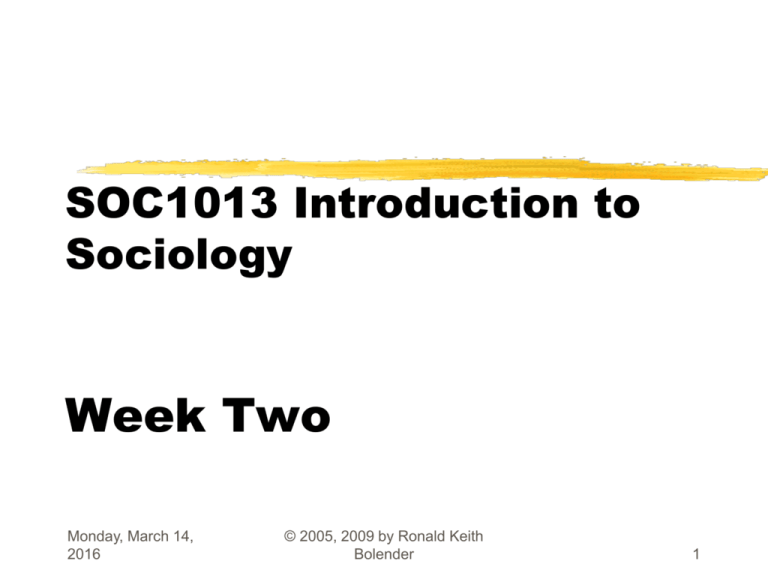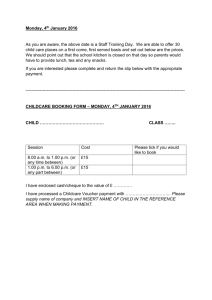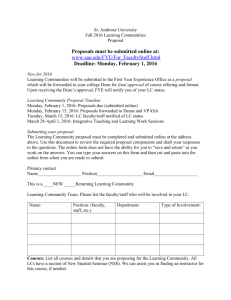
SOC1013 Introduction to
Sociology
Week Two
Monday, March 14,
2016
© 2005, 2009 by Ronald Keith
Bolender
1
Week Two
Compiled by:
Ronald Keith Bolender, Ed.D. (1996)
Nova Southeastern University
www.bolenderinitiatives.com
Monday, March 14,
2016
© 2005, 2009 by Ronald Keith
Bolender
2
Week Two
Important Copyright Note
This set of PowerPoint slides may only be
used in sections of SOC1013 Introduction
to Sociology where each student owns a
copy of The Meaning of Sociology (Charon
& Vigilant, 2009).
Monday, March 14,
2016
© 2005, 2009 by Ronald Keith
Bolender
3
Week Two
References
Charon, J. M., Vigilant, L. G. (2009). The meaning of
sociology (8th ed.). Upper Saddle River, NJ: Pearson
Prentice Hall.
Monday, March 14,
2016
© 2005, 2009 by Ronald Keith
Bolender
4
Week Two
Devotions
Monday, March 14,
2016
© 2005, 2009 by Ronald Keith
Bolender
5
Week Two:
ICA 2-1 Writing Assignment
ICA 2-1 In-class writing assignment over HWA 2-1, HWA 2-2,
and HWA 2-3
Purpose: To illustrate a basic understanding of
sociological concepts introduced in the reading
assignments for Week Two.
Grade: This assignment is worth a maximum of 25
points.
Content (maximum of 20 points): In addition to the
quality of the concepts and analysis presented—the
minimum length is 250 words.
Grammar, Spelling, and Sentence Structure (maximum
of 5 points)
Monday, March 14,
2016
© 2005, 2009 by Ronald Keith
Bolender
6
Week Two:
ICA 2-1 Writing Assignment
Instructions: Answer this question
from Chapter 4 Social Structure.
How do status positions form our
identities? How is this connected to
social structure?
PLEASE PRINT
Monday, March 14,
2016
© 2005, 2009 by Ronald Keith
Bolender
7
Week Two:
Chapter 4: Social Structure
We All Fill Positions in Social Structure
One of the patterns in social organization is called
social structure. Social structure refers to the fact that
individuals act toward one another according to their
position in the interaction. Over time, actors are located
in relation to one another in the interaction—they have
a “place”—and others act toward them according to
their place, and they act toward others according to
their place. These positions or places create a network
or what we might describe as a social map; this network
or map is called the social structure.
Monday, March 14,
2016
© 2005, 2009 by Ronald Keith
Bolender
8
Week Two:
Chapter 4: Social Structure
A social structure consists of a interrelated set of positions within
the social organization. Positions form a network—they all are
places in relation to all other positions—and they cannot be
described as isolated entities. Thus, a teacher is someone who
exists in relation to students, a husband in relation to wife, a boss
in relation to employees, etc.
A position is like a slot. This is an impersonal word, perhaps an
exaggeration, but it still emphasizes the fact that people are placed
in positions whenever they interact with others, and certainly
whenever they join an established organization.
As we interact with others, we focus our perceptions and actions
and expectations on where others are in relation to us. The more
technical name for position is status position. Some sociologists
prefer the term “status,” but position or status position is more
descriptive.
Monday, March 14,
2016
© 2005, 2009 by Ronald Keith
Bolender
9
Week Two:
Chapter 4: Social Structure
Roles Are Attached to Positions
Over time people within the interaction come to focus
on positions. Expectations are also called norms.
Norms can be informal and simply agreed upon in the
interaction, or they can be formal, written down, even becoming
a body of rules, a constitution, charter, or contract.
Norms can be stated, or they can be picked up from other
people’s actions.
Norms can be violated and met with only mild disapproval (you
are foolish; I am going to pretend I didn’t see that; stop it!), or
its violation can be met with fines, imprisonment, or even death.
Monday, March 14,
2016
© 2005, 2009 by Ronald Keith
Bolender
10
Week Two:
Chapter 4: Social Structure
The norms focusing on a position together are called a role. A role should
be thought of as a set of expectations, a script to be followed, a set of
behaviors and thoughts a person is expected to follow in a position.
Most of the time, we are barely aware of the script attached to our
position. The norms are accepted without consciously thinking about it. We
are expected to wear clothes in public, to be polite to people we meet, not
to embarrass people we do not know, to drive on the correct side of the
street, to use utensils when we eat. In a given day we will enter many
roles and act appropriately without thinking twice.
Some roles on the other hand are made very explicit and are very much
part of our conscious life. A marriage ceremony and certificate spells out
what is expected in the positions. A catcher on a baseball team, a police
officer on the street, the driver in a getaway car, and a private in the army
tend to be clearly defined and understood roles.
Monday, March 14,
2016
© 2005, 2009 by Ronald Keith
Bolender
11
Week Two:
Chapter 4: Social Structure
If you wonder if roles are really all that important, effective, or
impacting…consider an experiment conducted by Philip Zimbardo at
Stanford University.
He tested the effects of isolating normal, middle-class students
from the outside world for a couple of weeks, putting them in a
“prison situation” in which some them were in the position of guard
and some were in the position of prisoner.
Within a few days, these people became their roles—that is, the
guards actually came to act brutally, the prisoners really “wanted
out.” Something happened to everyone involved: A structure
evolved, the situation demanded new behaviors from everyone, and
the new roles took over.
The situation became so nightmarish that the study had to be
ended much earlier than planned.
Monday, March 14,
2016
© 2005, 2009 by Ronald Keith
Bolender
12
Week Two:
Chapter 4: Social Structure
Status Positions Form Our Identities
Much of our socialization involves learning
about the many status positions and roles in the
world. The child learns how firefighters and
dentists work, what grocery clerks and teachers
do. The child learns what Mom and Dad do,
what bad guys do, and what good students do.
The child plays at these roles, and in playing
them displays a recognition that he or she
knows the expectations attached to each.
Monday, March 14,
2016
© 2005, 2009 by Ronald Keith
Bolender
13
Week Two:
Chapter 4: Social Structure
An identity is who we see ourselves as. It is
the name we call ourselves and the name
we usually announce to others in our
actions. For most of us, gender is our most
important identity, but class position and
occupation are also very important.
To discover our identities all we really have to
do is list our positions in social structure and to
determine which positions are most important.
Monday, March 14,
2016
© 2005, 2009 by Ronald Keith
Bolender
14
Week Two:
Chapter 4: Social Structure
The identity I have situates me in relation
to others. I see who I am in relation to
them. Their acts remind me of who I am;
my acts toward them continue to tell
them who I am. Identity, like role, is
attached to my status position; it is my
“social address” in social structure.
IMPORTANT CONCEPT
Monday, March 14,
2016
© 2005, 2009 by Ronald Keith
Bolender
15
Week Two:
Chapter 4: Social Structure
Peter Berger describes the experience of a
newly commissioned office in the army—taking
on the role and identity of being an officer.
At first the new officer is slightly embarrassed having
enlisted personnel salute her/him.
With every salute given and accepted, the newly
commissioned officer begins to change her/his
attitude from one of slight embarrassment to one of
expectation of respect from enlisted personnel.
In a short period of time, the newly commissioned
officer becomes the role.
Monday, March 14,
2016
© 2005, 2009 by Ronald Keith
Bolender
16
Week Two:
Chapter 4: Social Structure
Positions Are Unequal
Status positions are not usually equal.
Inequality seems to be inherent in almost
all social structures.
Unequal Power
Social power refers to the ability one actor
has for achieving his or her will in relation to
others in the social organization.
Monday, March 14,
2016
© 2005, 2009 by Ronald Keith
Bolender
17
Week Two:
Chapter 4: Social Structure
A position that one occupies within an organization determines
the amount of power that person had to accomplish her/his will
over others.
One primary motivation for seeking promotions is to have more
power to accomplish one’s will.
It is critical to recognize that class, gender, and race are
structures with positions, and these positions also have power
attached to them. In general, although it is not necessarily
right, the wealthy have greater power in society than the poor,
men have more power than women, whites have more power
than nonwhites.
This is not a “law” of social nature—but rather a picture of the
current situation within the United States. As society evolves—
these power positions can change.
Monday, March 14,
2016
© 2005, 2009 by Ronald Keith
Bolender
18
Week Two:
Chapter 4: Social Structure
Unequal Prestige
Prestige refers to the honor that people in
social structure accord the position.
Many of us seek positions that give us honor
by others. Self-respect may be personal to
some extent: I am good, intelligent, honest,
capable. However, self-respect also comes
from “who we are” in relation to others. It is
associated with the position we fill in social
structure.
Monday, March 14,
2016
© 2005, 2009 by Ronald Keith
Bolender
19
Week Two:
Chapter 4: Social Structure
Unequal Privileges
Positions also bring with them privileges, the
good things so to speak, the benefits, the
opportunities that come to those filling the
position. These privileges may be high
income and other material benefits,
opportunity to choose one’s own office
furniture, choice of home, long vacations, a
secretary, quality schooling, an expensive car.
Monday, March 14,
2016
© 2005, 2009 by Ronald Keith
Bolender
20
Week Two:
Chapter 4: Social Structure
In addition to role and an identity, then,
each status position also has a certain
amount of power, a certain degree of
prestige, and privileges attached—or
denied.
Different amounts of power,
prestige, and privilege create the
inequality within the social structure.
Monday, March 14,
2016
© 2005, 2009 by Ronald Keith
Bolender
21
Week Two:
Chapter 4: Social Structure
A note before showing the next
slide…
If you can understand this next
section, you are on your way to
thinking like a sociologist!
Monday, March 14,
2016
© 2005, 2009 by Ronald Keith
Bolender
22
Week Two:
Chapter 4: Social Structure
Our Positions Give Us Our Perspectives
IMPORTANT CONCEPT
Social positions give us the eyeglasses through
which we look at the world. People define the
world according to where they are located
(socially).
Boss versus employee
Wealthy versus poor
Upper middle class versus the working class (blue
collar)
Monday, March 14,
2016
© 2005, 2009 by Ronald Keith
Bolender
23
Week Two:
Chapter 4: Social Structure
Our status position may also influence how we
look at the world in general. Not only does a
corporate executive see the corporation
differently from the man or woman who works
on the assembly line, but the executive probably
has a different view of government, capitalism,
foreign policy, American education, and perhaps
even religion.
What we think is true, what we value, what we
believe is wrong or right in the world arises from our
position.
Monday, March 14,
2016
© 2005, 2009 by Ronald Keith
Bolender
24
Week Two:
Chapter 4: Social Structure
First, we are socialized into our positions: not only in how to act
and who we are but also in how to think, how to approach
understanding reality.
Second, each position is in fact a location in organization, a point
within it, and thus an angle of perception used to understand
what is taking place in and outside the organization. Each position
is a place from which we look, causing us to see reality at that
particular angle.
The third reason we are influenced to see the world through our
position has to do with our desire to successfully enact the
position. Success in position means that we have to understand
how people in that position think. We have to understand how
others who are somehow linked to that position expect us to think
in that position.
This is a complex process.
Monday, March 14,
2016
© 2005, 2009 by Ronald Keith
Bolender
25
Week Two:
Chapter 5: Inequality in Society
An Important Note about this Section
The “tone of voice” in this section is “matter-of-fact,” or
neutral. This is NOT a “slam” the United States of
America section. The curriculum writer is pro-America in
terms of opportunities for those who are willing to
sacrifice and strive toward a goal. However, an
educated person needs to develop an “objective” nature
in looking at reality. The reality is that inequality is the
American-way. While we do not desire certain types of
inequality (such as gender and race)—most Americans
accept and celebrate other forms of inequality (sports
figures, entertainment celebrities, etc.). When it comes
to the subject of social inequality—often we contradict
ourselves.
Monday, March 14,
2016
© 2005, 2009 by Ronald Keith
Bolender
26
Week Two:
Chapter 5: Inequality in Society
It is part of the American way of thinking that
the United States is a land of opportunity for
all—that all have a roughly equal chance to
succeed. It is difficult for us to see that
inequality is built into the very nature of society,
that we are in fact all part of social structures
that work against equal opportunity. Most of us
spend much of our lives trying to “make it” in a
society we perceive to be open.
Monday, March 14,
2016
© 2005, 2009 by Ronald Keith
Bolender
27
Week Two:
Chapter 5: Inequality in Society
Yet we have always had inequality in society.
We have always had a few privileged people and a
large number of poor.
We have always had class inheritance within families,
and we have always had opportunities limited by
class in virtually every aspect of live:
government
education
health care
choice of neighborhood
the law and the courts
Monday, March 14,
2016
© 2005, 2009 by Ronald Keith
Bolender
28
Week Two:
Chapter 5: Inequality in Society
There are several reasons why inequality is difficult for
us to see.
First, equal opportunity has been a central part of the heritage
we have been taught.
Second, many people have come up to the United States from
societies with much less opportunity, and have been able to
succeed here where they would not have had the opportunity to
succeed in their homeland.
Third, because of the tremendous industrial growth in the
United States throughout most of the 20th century, almost
everyone’s position has improved over that of his or her
parents.
Fourth, inequality is easily hidden, especially at the extremes of
poverty and wealth.
Monday, March 14,
2016
© 2005, 2009 by Ronald Keith
Bolender
29
Week Two:
Chapter 5: Inequality in Society
The Meaning of Social Class
One’s class is most easily understood as
one’s position in the class structure in
society. One’s class position depends on
economic criteria, the most easily
understood being income and wealth.
Monday, March 14,
2016
© 2005, 2009 by Ronald Keith
Bolender
30
Week Two:
Chapter 5: Inequality in Society
Social class is like all other structures of which
we are a part: It is made up of status positions
(classes), each of which influences the actor’s
actions by giving him or her
Power
Prestige
Privilege
Identity
Role
Perspective
Monday, March 14,
2016
© 2005, 2009 by Ronald Keith
Bolender
31
Week Two:
Chapter 5: Inequality in Society
Class, Race, and Gender Structures Are
Special Social Structures
Class, race, and gender are all social
structures in society, but they are also
very special structures, characterized by
the following qualities.
The individual is placed in all three at birth.
One’s initial position depends on biology or
family.
Monday, March 14,
2016
© 2005, 2009 by Ronald Keith
Bolender
32
Week Two:
Chapter 5: Inequality in Society
The individual’s position in all three is perpetuated by
the family.
That is, the family directly places the individual (for
example, by determining race or bestowing wealth), and the
family teaches the position to the individual (for example,
how to act “like a man” or how to be a “young lady” or the
way that “people like us” are supposed to act).
The individual’s position in these structures
influences placement in most other structures.
In government, in business, in the military, or in education,
what one can achieve is influenced by class, race, and
gender positions.
Monday, March 14,
2016
© 2005, 2009 by Ronald Keith
Bolender
33
Week Two:
Chapter 5: Inequality in Society
The individual’s position in these structures is
generally fixed.
We cannot, of course, change race or gender.
Class position may be less fixed, but for the vast
majority of people, class placement at birth has a
strong influence: The rich generally stay rich, the
poor stay poor, and those in between move
slightly above or below where they were born.
Class position at birth acts as a constraining force:
It does not determine where one ends up, but it
does act as an important influence.
Monday, March 14,
2016
© 2005, 2009 by Ronald Keith
Bolender
34
Week Two:
Chapter 5: Inequality in Society
Various institutions in society cooperate to
protect and perpetuate the structures as they
have developed.
Political, legal, economic, educational, religious,
and kinship institutions socialize us, encourage
us, and reward us to accept the existing social
patterns and our place in them. Often, the
structures are presented as just, moral, and
natural; opposition to them is condemned as
immoral or unpatriotic and is subject to
punishment.
Monday, March 14,
2016
© 2005, 2009 by Ronald Keith
Bolender
35
Week Two:
Chapter 5: Inequality in Society
These structures are embedded in a long history.
They are therefore difficult to challenge or alter. We are used
to them. They are less open to challenge than structures
created in other forms of organization such as groups and
formal organizations. It is difficult for most of us to see
realistic alternatives to them because they seem so much an
integral part of our taken-for-granted world. Even for those of
us who want to do away with them (or at least to alter them),
it is often difficult to make sound suggestions about how to
institute workable changes.
Monday, March 14,
2016
© 2005, 2009 by Ronald Keith
Bolender
36
Week Two:
Chapter 5: Inequality in Society
The term social stratification or stratification
system is generally applied to social structures that are
relatively fixed, such as class, race, and gender.
Stratification, of course, is a concept borrowed from
geology, where it refers to the layering of rocks beneath
the earth surface. A system of social stratification is
similar to layers of rock: It is ageless, relatively
permanent, and individuals in each layer are embedded.
Yet, of course, earthquakes sometimes occur—they are
relatively rare but powerful—and foundations are
shaken. Profound changes can then occur.
Monday, March 14,
2016
© 2005, 2009 by Ronald Keith
Bolender
37
Week Two:
Chapter 5: Inequality in Society
The Origin of Social Stratification Systems
If we define conflict as the struggle for whatever is
valued among people, we can realize that whenever
something is valued that cannot equally belong to
everyone, there will be conflict—struggles over what is
valued. Some win, some lose. As some win they will try
to consolidate their position as best they can; those who
lose are placed in a position that makes it difficult for
them to win in the future. The power of those who win
increases over time, and the social patterns that emerge
in society (which the powerful encourage) tend to favor
their interests.
Monday, March 14,
2016
© 2005, 2009 by Ronald Keith
Bolender
38
Week Two:
Chapter 5: Inequality in Society
The social stratification process.
In any society, whatever is valued will always
be in short supply. When this occurs, humans
will pursue these values for themselves, and
some, because of personal or group
advantage, will be more successful than
others in obtaining them.
Monday, March 14,
2016
© 2005, 2009 by Ronald Keith
Bolender
39
Week Two:
Chapter 5: Inequality in Society
Obtaining and keeping material goods through the
successful application of personal or group power
brings an accumulation of goods (privileges). Both
power and privileges in turn bring prestige.
Both prestige and control over valued goods bring, in
turn, more power.
The system of distribution, created out of personal
power or group advantage, is eventually justified; it
becomes “legitimate,” or regarded as right. Inequality
is protected by the power of a few, and eventually by
the ideas developed in society.
Monday, March 14,
2016
© 2005, 2009 by Ronald Keith
Bolender
40
Week Two:
Chapter 5: Inequality in Society
Finally, advantages are passed down to
offspring. Possession of goods is not
associated with person but with family. A
class system is thus created and perpetuated.
Monday, March 14,
2016
© 2005, 2009 by Ronald Keith
Bolender
41
Week Two:
Chapter 5: Inequality in Society
Social Mobility
Social mobility refers to change in the
individual’s class either in relation to his or
her parents or during his or her own
lifetime. We say that a society has high
mobility where individuals are likely to
change their positions.
Monday, March 14,
2016
© 2005, 2009 by Ronald Keith
Bolender
42
Week Two:
Chapter 5: Inequality in Society
We cannot change our gender or race. These are called
ascribed qualities (rather than achieved qualities) and
cannot be escaped. Individual blacks or women can
achieve much in society in spite of the fact that it is
more difficult for them, but they will always remain
black or women. As long as these qualities are important
for placing people in society, the individual will be
affected.
Class is slightly different. Because it is based on
economic criteria, it is achieved, at least to some
degree.
Societies differ in the extent to which class mobility is
possible.
Monday, March 14,
2016
© 2005, 2009 by Ronald Keith
Bolender
43
Week Two:
Chapter 5: Inequality in Society
Structural Change
Nothing stays the same. Over time, structures change. As
they do, opportunities open up for people long deprived,
and those who have always had privileges are forced to
surrender some. For example, since World War II, there
has been a steady change in the relationship between
men and women. As women have entered the paid labor
force, expectations have changed about what women’s
roles are, and their power, privileges, and prestige have
all become more equal to those of men. Widespread use
of birth control, the women’s movement, longer lifespans,
and the increasing independence of children have all
contributed to this changing gender structure.
Monday, March 14,
2016
© 2005, 2009 by Ronald Keith
Bolender
44
Week Two:
Chapter 5: Inequality in Society
Marx’s View of Social Stratification
Marx believed that economic class was central to society because all
other systems of inequality were dependent on it.
Marx also argued that the powerful determine the ideas that prevailed
in the society. They were in the best position to each what they
considered the truth, and the ideas they taught would be in their own
interests—for example, competition is a law of nature, poverty is
inevitable, protection of private property is more important than
protection of workers’ rights or people’s lives.
Marx saw that those who have the power also have the privileges in
the society. They have longer lives, better health care; higher
educational opportunities, more leisure time, comfort, and security.
Monday, March 14,
2016
© 2005, 2009 by Ronald Keith
Bolender
45
Week Two:
Chapter 6: Culture
Culture is the second pattern of social
organization. Like social structure (the
other pattern), it is developed in
interaction over time; it determines much
of what the individual does; and it allows
for continuity, stability, and
predictability among people.
Monday, March 14,
2016
© 2005, 2009 by Ronald Keith
Bolender
46
Week Two:
Chapter 6: Culture
Culture Is a Shared Perspective on the World
From a sociological viewpoint, culture
does not mean violins, poetry, or art.
The sociological definition of culture is:
A perspective on the world that people come
to share as they interact.
It is what people come to agree on, their
consensus, their shared reality, their common
ideas.
Monday, March 14,
2016
© 2005, 2009 by Ronald Keith
Bolender
47
Week Two:
Chapter 6: Culture
Within the United States, each community,
each formal organization, each group and
dyad has its own culture (or what some social
scientists call a subculture because it is a
culture within another culture).
Whereas structure emphasizes differences
(people relate to each other in terms of their
different positions), culture emphasizes
similarities (how they agree). IMPORTANT
CONCEPT
Monday, March 14,
2016
© 2005, 2009 by Ronald Keith
Bolender
48
Week Two:
Chapter 6: Culture
Culture is made up of what people come to share in
their heads—their ideas about what is true, right,
and important. Such ideas are guides to what we do,
they determine many of our choices, they have far
more consequences than simply being carried around
in our heads. We should think of our culture as
shared in interaction, constituting our agreedon perspective of the world, and directing our
acts in the world.
Monday, March 14,
2016
© 2005, 2009 by Ronald Keith
Bolender
49
Week Two:
Chapter 6: Culture
Culture Is Learned
To argue that culture is important is to
believe that learning about the world and how
to act in it is a result of socialization in
contrast to biology. IMPORTANT
CONCEPT
It is also to believe that humans do not simply
imitate, but they learn about the world from
other people who teach them through
language. Culture is that which we learn and
come to believe.
Monday, March 14,
2016
© 2005, 2009 by Ronald Keith
Bolender
50
Week Two:
Chapter 6: Culture
Culture Is a Social Inheritance
Many social organizations we enter have existed for a long time;
people who have power within them teach us their longestablished “truths” so that we may become good members and
the social organization will continue.
Culture is a social inheritance; it consists of ideas that may have
developed long before we were born.
Our society, for example, has a history reaching beyond any
individual’s life, the ideas developed over time are taught to
each generation and “truth” is anchored in interaction by people
long dead.
Do you find this fascinating? People in their “graves” are
influencing our thoughts and guiding our social actions.
Monday, March 14,
2016
© 2005, 2009 by Ronald Keith
Bolender
51
Week Two:
Chapter 6: Culture
Here are some examples from the middle class:
Successful people must get a college diploma
Women should marry and have children
Romantic love should be the basis for marriage
Making money is the best way to encourage people to work
Each child is taught this culture by the family, school,
and church—those social organizations that are its
carriers.
We are socialized to accept the ideas of those in
the positions of “knowing better,” those who have
many years of history on their side, a long tradition,
rightness or God or science or whatever.
Monday, March 14,
2016
© 2005, 2009 by Ronald Keith
Bolender
52
Week Two:
Chapter 6: Culture
A culture, then is a shared perspective, a
set of ideas that people develop and
learn in social interaction. Ideas can be
subdivided into three categories.
What is true (our truths)
What is worthwhile (our values and goals)
What is the correct way of acting (our rules)
Monday, March 14,
2016
© 2005, 2009 by Ronald Keith
Bolender
53
Week Two:
Chapter 6: Culture
Culture Is a Body of “Truth”
A culture is, first of all, a set of ideas
concerning what is true or real.
Almost all of us like to think that our ideas
about the world are true. Some of them
are, but most of them we have come to
accept not because of careful evidence,
but because of our interaction.
Monday, March 14,
2016
© 2005, 2009 by Ronald Keith
Bolender
54
Week Two:
Chapter 6: Culture
Culture Is a Set of Values and Goals
Culture is also made up of ideas about
what is worth working for (ends). These
ends are of two kinds: values and goals.
Sometimes, the distinction between
values and goals is difficult to make
because both consist of ideas about what
we should pursue, what purpose our
action should have.
Monday, March 14,
2016
© 2005, 2009 by Ronald Keith
Bolender
55
Week Two:
Chapter 6: Culture
Values
A value is a long-range commitment of the
organization or individual. It is a strong preference, an
organizing principle around which goals are established
and action takes place.
Goals
A goal is a short-range objective in a specific situation
by an individual or social organization.
Monday, March 14,
2016
© 2005, 2009 by Ronald Keith
Bolender
56
Week Two:
Chapter 6: Culture
Culture Is a Set of Norms
Norms are the expectations we have for each
other—how we are supposed to act—the rules,
the laws, the right way.
Norms are associated with one’s position and
are thus part of structure (remember, they
make up a role), but they are also associated
with membership in the group, irrespective of
position (they make up the culture).
Monday, March 14,
2016
© 2005, 2009 by Ronald Keith
Bolender
57
Week Two:
ICA 2-2 In-class Work Session
ICA 2-2 In-class Work Session on the HWA 5-1 Socio-Autobiography Project
The facilitating instructor will assign students into groups.
The purpose of this work session is to “brainstorm” about the HWA 51 Socio-Autobiography Project.
Each group should review all of the requirements for this assignment.
Each student should “brainstorm” regarding how they will approach
and fulfill the requirements of the assignment.
By the end of this in-class work session, every student should have a
clear understanding of the assignment.
For those who complete the minimum requirements of ICA 2-2 before
the rest of the class, the remaining time should be spent writing.
Monday, March 14,
2016
© 2005, 2009 by Ronald Keith
Bolender
58
Week Two
Review homework assignments (HWAs)
for Week Three.
Monday, March 14,
2016
© 2005, 2009 by Ronald Keith
Bolender
59






